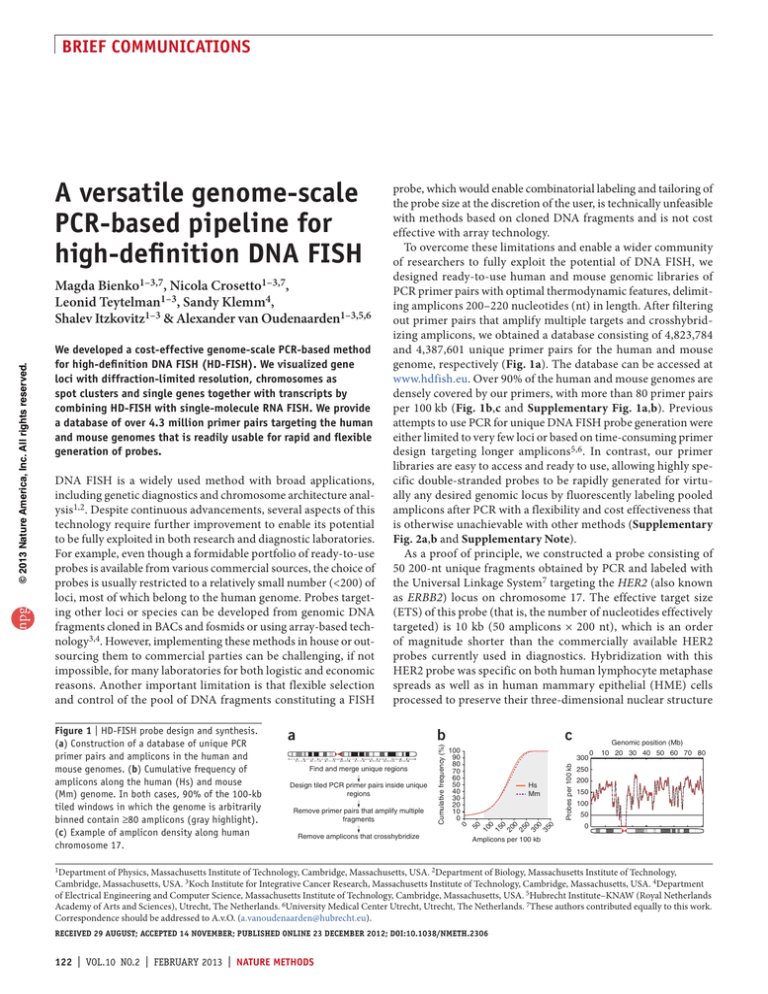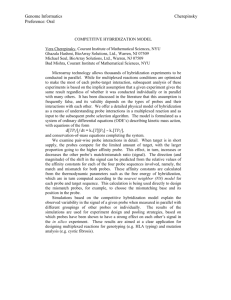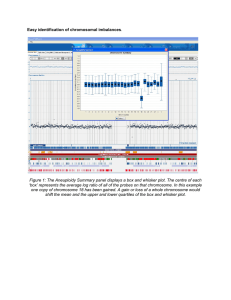
brief communications
A versatile genome-scale
PCR-based pipeline for
high-definition DNA FISH
We developed a cost-effective genome-scale PCR-based method
for high-definition DNA FISH (HD-FISH). We visualized gene
loci with diffraction-limited resolution, chromosomes as
spot clusters and single genes together with transcripts by
combining HD-FISH with single-molecule RNA FISH. We provide
a database of over 4.3 million primer pairs targeting the human
and mouse genomes that is readily usable for rapid and flexible
generation of probes.
DNA FISH is a widely used method with broad applications,
including genetic diagnostics and chromosome architecture analysis1,2. Despite continuous advancements, several aspects of this
technology require further improvement to enable its potential
to be fully exploited in both research and diagnostic laboratories.
For example, even though a formidable portfolio of ready-to-use
probes is available from various commercial sources, the choice of
probes is usually restricted to a relatively small number (<200) of
loci, most of which belong to the human genome. Probes targeting other loci or species can be developed from genomic DNA
fragments cloned in BACs and fosmids or using array-based technology3,4. However, implementing these methods in house or outsourcing them to commercial parties can be challenging, if not
impossible, for many laboratories for both logistic and economic
reasons. Another important limitation is that flexible selection
and control of the pool of DNA fragments constituting a FISH
b
Probes per 100 kb
0
0
0
35
30
0
0
0
25
Remove amplicons that crosshybridize
Hs
Mm
20
Remove primer pairs that amplify multiple
fragments
300
15
Find and merge unique regions
Design tiled PCR primer pairs inside unique
regions
c
100
90
80
70
60
50
40
30
20
10
0
10
a
0
50
Figure 1 | HD-FISH probe design and synthesis.
(a) Construction of a database of unique PCR
primer pairs and amplicons in the human and
mouse genomes. (b) Cumulative frequency of
amplicons along the human (Hs) and mouse
(Mm) genome. In both cases, 90% of the 100-kb
tiled windows in which the genome is arbitrarily
binned contain ≥80 amplicons (gray highlight).
(c) Example of amplicon density along human
chromosome 17.
Cumulative frequency (%)
npg
© 2013 Nature America, Inc. All rights reserved.
Magda Bienko1–3,7, Nicola Crosetto1–3,7,
Leonid Teytelman1–3, Sandy Klemm4,
Shalev Itzkovitz1–3 & Alexander van Oudenaarden1–3,5,6
probe, which would enable combinatorial labeling and tailoring of
the probe size at the discretion of the user, is technically unfeasible
with methods based on cloned DNA fragments and is not cost
effective with array technology.
To overcome these limitations and enable a wider community
of researchers to fully exploit the potential of DNA FISH, we
designed ready-to-use human and mouse genomic libraries of
PCR primer pairs with optimal thermodynamic features, delimiting amplicons 200–220 nucleotides (nt) in length. After filtering
out primer pairs that amplify multiple targets and crosshybridizing amplicons, we obtained a database consisting of 4,823,784
and 4,387,601 unique primer pairs for the human and mouse
genome, respectively (Fig. 1a). The database can be accessed at
www.hdfish.eu. Over 90% of the human and mouse genomes are
densely covered by our primers, with more than 80 primer pairs
per 100 kb (Fig. 1b,c and Supplementary Fig. 1a,b). Previous
attempts to use PCR for unique DNA FISH probe generation were
either limited to very few loci or based on time-consuming primer
design targeting longer amplicons5,6. In contrast, our primer
libraries are easy to access and ready to use, allowing highly specific double-stranded probes to be rapidly generated for virtually any desired genomic locus by fluorescently labeling pooled
amplicons after PCR with a flexibility and cost effectiveness that
is otherwise unachievable with other methods (Supplementary
Fig. 2a,b and Supplementary Note).
As a proof of principle, we constructed a probe consisting of
50 200-nt unique fragments obtained by PCR and labeled with
the Universal Linkage System7 targeting the HER2 (also known
as ERBB2) locus on chromosome 17. The effective target size
(ETS) of this probe (that is, the number of nucleotides effectively
targeted) is 10 kb (50 amplicons × 200 nt), which is an order
of magnitude shorter than the commercially available HER2
probes currently used in diagnostics. Hybridization with this
HER2 probe was specific on both human lymphocyte metaphase
spreads as well as in human mammary epithelial (HME) cells
processed to preserve their three-dimensional nuclear structure
0
Genomic position (Mb)
10 20 30 40 50 60 70 80
250
200
150
100
50
0
Amplicons per 100 kb
1Department of Physics, Massachusetts Institute of Technology, Cambridge, Massachusetts, USA. 2Department of Biology, Massachusetts Institute of Technology,
Cambridge, Massachusetts, USA. 3Koch Institute for Integrative Cancer Research, Massachusetts Institute of Technology, Cambridge, Massachusetts, USA. 4Department
of Electrical Engineering and Computer Science, Massachusetts Institute of Technology, Cambridge, Massachusetts, USA. 5Hubrecht Institute–KNAW (Royal Netherlands
Academy of Arts and Sciences), Utrecht, The Netherlands. 6University Medical Center Utrecht, Utrecht, The Netherlands. 7These authors contributed equally to this work.
Correspondence should be addressed to A.v.O. (a.vanoudenaarden@hubrecht.eu).
Received 29 August; accepted 14 November; published online 23 December 2012; DOI:10.1038/NMETH.2306
122 | VOL.10 NO.2 | FEBRUARY 2013 | nature methods
brief communications
Relative frequency (%)
Figure 3 | Versatility of HD-FISH. (a) Chromosome 17 spotting with ten
alternatively labeled HD-FISH probes in metaphase spreads (left) and
HME cells (middle, with a three-dimensional rendering on the right).
(b) Spot quantification of the HME cells in a. (c) Chromosome 17 spotting
with 16 HD-FISH probes (green and magenta) and paint probes (blue)
(left and middle, Z projections; right, three-dimensional rendering).
(d) Chromosome 17 volume estimation using spotting (purple) compared
to paint signals at different thresholds (brown gradient). Inset, range
of median values for the curves on the left. Purple line, spotting signal
median volume. (e,f) Visualization (e) and quantification (f) of HER2 loci
(magenta) and transcripts (green) in HME cells. (g) HER2 loci (magenta)
and transcripts (green) in breast cancer stroma (above dashed white
lines) compared to tumor cells (below dashed white lines). The n values
indicate the number of cells analyzed. Scale bars, 10 µm; inset (a),
5.5× magnification.
Volume
3
(µm )
Relative
frequency (%)
Relative
frequency (%)
c
0
0
e
g
f
mRNA count
© 2013 Nature America, Inc. All rights reserved.
npg
b
Relative frequency (%)
and HD-FISH spot clusters, we performed
simultaneous hybridization in HME cells
mRNA
3 kb
80
using HD-FISH spotting and paint probes
3 kb
10 kb
60
60
10 kb
460 kb
against chromosomes 1 and 17. By visual
40
460 kb
40
inspection, HD-FISH spot clusters over20
20
lapped largely with the chromosome terri0
0
tories, further emphasizing the specificity
200 300 400 500 600 700
0
2
4
6
8
Spots per nucleus
Spot size (nm)
of our approach (Fig. 3c, Supplementary
Figure 2 | Specificity and sensitivity of HD-FISH. (a) Human HER2 locus (red) visualized in
Fig. 4e and Supplementary Videos 1
metaphase spreads (left) and HME cells (right) using a 10-kb ETS probe. Blue, DAPI. Scale bars,
and 2). Taking advantage of the high opti10 µm; inset, 2.3× magnification. (b) Distributions of spot counts for three loci on chromosome 17,
cal resolution of the HD-FISH signals,
including HER2, visualized with 10-kb compared to 3-kb ETS probes and a HER2 commercial probe
we next performed three-dimensional
spanning 460 kb. (c) Distribution of spot sizes for the same HER2 probe as in a. mRNA, diffractiontriangulation of the clustered HD-FISH
limited HER2 mRNA molecules detected by smRNA FISH.
spots for chromosome 17, demonstrating that with probes spaced evenly every
(using three-dimensional FISH)8. Eighty-five percent of inter- 5 Mb, the nucleus occupancy volume of the HD-FISH clusters
phase nuclei contained between two and four loci, as can be and the corresponding chromosome territories visualized with
expected in dividing diploid cells (Fig. 2a). We obtained simi- paint probes resulted in similar volumes (Fig. 3d). In many cases,
lar count distributions for HER2 and other loci on chromosome however, we detected isolated HD-FISH spots in regions with
17 over a broad range of ETSs down to 3 kb, demonstrating the low-intensity paint signals on chromosomes 1 and 17, possibly
sensitivity of our method even with probes derived from only reflecting better sampling of chromosome volumes (Fig. 3c and
15 amplicons (Fig. 2b and Supplementary Fig. 3). Notably, a Supplementary Fig. 4b,e,f).
probe against HER2 with a 3-kb ETS yielded signals with a size
To extend further the versatility of our method, we combined
(mean diameter, 362 ± 31 nm (mean ± s.d.)) that was similar to it with single-molecule RNA FISH (smRNA FISH)10 in HME
the diffraction limit of the microscope used (Fig. 2c). For this cells, simultaneously detecting individual HER2 loci, sites of
active transcription and mature HER2 transcripts (Fig. 3e). The
reason, we named our method HD-FISH.
To demonstrate the scalability of our method, we simultane- number of HER2 transcripts scaled proportionally to the number
ously targeted multiple loci spaced evenly on chromosomes 1 of HER2 loci (with a mean of 10.4 HER2 mRNA counts for two
DNA loci compared to 20.1 HER2 mRNA counts for four DNA
and 17 using probes labeled with two alternating fluorophores
loci; Kolmogorov-Smirnov test P = 3 × 10−45), which is in agree(Supplementary Fig. 4a). Much as with single-locus probes, this
‘spotting’ strategy was specific on both metaphase spreads as well ment with previous observations11 (Fig. 3f and Supplementary
as on HME interphase cell nuclei after three-dimensional HD- Fig. 5). We also used HD-FISH and smRNA FISH in combinaFISH, allowing for the precise enumeration of targeted chromo- tion on formalin-fixed paraffin-embedded breast cancer tissue
somes (Fig. 3a,b, Supplementary Fig. 4b and Supplementary sections. In HER2-positive breast cancers, we found HER2
Video 1). The numbers of spots detected with the first and
second fluorophore in the same cell were highly concordant
a
b
(Supplementary Fig. 4c,d), indicating that the type of fluoro20
n = 744
phore does not influence the HD-FISH hybridization efficiency.
15
Notably, our chromosome-spotting strategy was substantially
10
5
more rapid and cost effective compared to alternative available
0
methods (Supplementary Fig. 2a,b and Supplementary Note).
0
20
40
60
Signal per nucleus
In the interphase nuclei, HD-FISH spotting yielded clusters
c
d 8
of variable size, shape and density that were reminiscent of the
14
12
6
chromosomal territories visualized with paint probes9. To inves10
8
4
6
tigate the spatial relationship between chromosome territories
2
a
20 40 60 80
Nucleus occupancy
3
volume (µm )
40
n = 445
30
20
10
0
2
3
4
Number of loci
nature methods | VOL.10 NO.2 | FEBRUARY 2013 | 123
amplification coupled to high HER2 mRNA expression in tumor
areas but not in intratumoral stroma, confirming the specificity
of our probes (Fig. 3g).
HD-FISH can reliably operate at the resolution limit of conventional optical microscopy because of the systematic design of short,
unique probes that enable visualization of virtually any human or
mouse genomic locus. Diffraction-limited HD-FISH spots are
treated as digital instead of analog signals, allowing a thresholdinsensitive quantification that is more robust than that obtained
using existing methods. Our method is logistically simple, rapid and
cost effective and is therefore especially relevant for research laboratories that do not use FISH techniques routinely but wish to study
loci for which no probe is commercially available. Our method
enables a flexibility that is unachievable with current technologies:
because unique primers are synthesized in 96-well plates and PCR
reactions are performed separately, different probes consisting of
subsets of unique amplicons can be easily and rapidly obtained
and combinatorially labeled from the same set of primers. Flexible
combinatorial labeling of HD-FISH spotting probes will enable the
study of chromosome organization in situ by determining precisely
the relative position of reference points within spotting clusters.
Combining high-definition DNA and RNA FISH methods allows
systematic in situ analyses of the association between chromosome
organization and gene expression, which has not been possible so
far because of a lack of robust single-cell quantitative assays. HDFISH is a powerful method for research and diagnostics with broad
applications ranging from the diagnosis of chromosomal aberrations to chromosome architecture studies.
Note added in proof: While the galley proof of this article was in
preparation, Beliveau et al.12 reported a method for genome-scale
generation of DNA FISH probes using microarray oligonucleotide
libraries.
Methods
Methods and any associated references are available in the online
version of the paper.
npg
© 2013 Nature America, Inc. All rights reserved.
brief communications
124 | VOL.10 NO.2 | FEBRUARY 2013 | nature methods
Note: Supplementary information is available in the online version of the paper.
Acknowledgments
We thank P. Junker and S. Semrau for helpful discussions. We are grateful to R.A.
Weinberg (Massachusetts Institute of Technology) for providing hTERT-HME1
cells. This work was supported by the US National Institutes of Health (NIH)/
National Cancer Institute Physical Sciences Oncology Center at Massachusetts
Institute of Technology (U54CA143874), an NIH Pioneer award (1DP1OD003936)
and a Nederlandse Organisatie voor Wetenschappelijk Onderzoek Vici award to
A.v.O. M.B. and S.I. are sponsored by the Human Frontiers Science Program.
AUTHOR CONTRIBUTIONS
N.C. and A.v.O. conceived the methods. M.B. and N.C. performed experiments,
analyzed the data and wrote the manuscript. L.T. generated the genome-wide
primer databases, designed the probes and wrote the manuscript. S.K. and S.I.
developed software for image processing, provided suggestions on data analysis
and corrected the manuscript. A.v.O. guided experiments and data analysis, and
wrote the manuscript.
COMPETING FINANCIAL INTERESTS
The authors declare no competing financial interests.
Published online at http://www.nature.com/doifinder/10.1038/nmeth.2306.
Reprints and permissions information is available online at http://www.nature.
com/reprints/index.html.
1. Springer Protocols. Fluorescence In Situ Hybridization (FISH)–Application
Guide (ed. Liehr, T.) (Springer, 2008).
2. Springer Protocols. Fluorescence In Situ Hybridization (FISH): Protocols and
Applications (Methods in Molecular Biology). (eds Bridger, J.M. & Volpi, E.V.)
(Humana Press, 2010).
3. Boyle, S., Rodesch, M.J., Halvensleben, H.A., Jeddeloh, J.A. & Bickmore, W.A.
Chromosome Res. 19, 901–909 (2011).
4. Yamada, N.A. et al. Cytogenet. Genome Res. 132, 248–254 (2011).
5. Rogan, P.K., Cazcarro, P.M. & Knoll, J.H. Genome Res. 11, 1086–1094
(2001).
6. Navin, N. et al. Bioinformatics 22, 2437–2438 (2006).
7. Wiegant, J.C. et al. Cytogenet. Cell Genet. 87, 47–52 (1999).
8. Solovei, I. & Cremer, M. Methods Mol. Biol. 659, 117–126 (2010).
9. Cremer, T. & Cremer, M. Cold Spring Harb. Perspect. Biol. 2, a003889 (2010).
10. Raj, A., van den Bogaard, P., Rifkin, S.A., van Oudenaarden, A. & Tyagi, S.
Nat. Methods 5, 877–879 (2008).
11. Tsafrir, D. et al. Cancer Res. 66, 2129–2137 (2006).
12. Beliveau, B.J. et al. Proc. Natl. Acad. Sci. USA published online,
doi:10.1073/pnas.1213818110 (2012).
npg
© 2013 Nature America, Inc. All rights reserved.
ONLINE METHODS
Genome-wide primer design. Each chromosome was split
in silico into 500-nt tiled fragments with 100-nt sliding steps.
Fragments were aligned to the genome of interest (hg19/GRCh37
assembly for Homo sapiens and NCBIm37/mm9 assembly for
Mus musculus) using BLAT (http://genome.ucsc.edu/FAQ/
FAQblat.html) set to find matches in the genome with 80% or
higher similarity13. Overlapping unique fragments were merged
together. Next, Primer3 (http://primer3.sourceforge.net/) in
default mode was run on merged unique DNA sequences to
design tiled primer pairs delimiting 200- to 220-nt amplicons14.
To avoid cross amplification, each primer pair was screened
for specificity using electronic PCR (http://www.ncbi.nlm.nih.
gov/projects/e-pcr/) with 0- to 2-nt mismatches allowed per
primer15. Primer pairs yielding non-self products were discarded.
Amplicons delimited by unique primer pairs were individually
screened for specificity by another round of BLAT searching
against the genome of interest. Amplicons with 70% or higher
similarity outside their locus were discarded.
Generation of HD-FISH probes. For each probe, forward and
reverse primers were synthesized in corresponding wells of separate 96-well plates (stock plates). Forward and reverse primer
pairs were mixed and diluted to 5 µM in nuclease-free water using
PCR plates (clear LightCycler 480 Multiwell Plate 96, Roche)
(dilution plates) at well positions matching the positions of the
primers in the stock plate. For each probe, real-time PCR reactions were carried out in the same type of plates (experimental
plates) by transferring the appropriate volume of the 5 µM primer
dilution from the dilution plate to the corresponding well in the
experimental plate. For each reaction (in one well), the following
reagents were mixed: 25 µl KAPA SYBR FAST qPCR Master Mix
2×, 4 µl of the 5 µM forward and reverse primers dilution, 1 µl
human genomic DNA (diluted 50 ng/µl in Tris-EDTA (TE) buffer,
pH 8) and 20 µl nuclease-free water. For each plate, 30 cycles of
real-time PCR reactions were performed in a LightCycler 480
instrument (Roche) using the default SYBRGreen program with
Ta = 55 °C. After PCR, the contents of all the wells corresponding to a given probe were pooled together in a sterile cell culture
basin (VWR) and aliquoted for subsequent ethanol precipitation.
Wells in which either no product was observed or the amplification kinetics were substantially different than those in all other
wells were excluded.
For labeling, a volume corresponding to 1 µg of each probe was
lyophilized and then labeled with the fluorophore of interest using
the corresponding ULYSIS Nucleic Acid Labeling Kit (Invitrogen)
according to the manufacturer’s instructions. Unbound dyes
were removed by gel filtration using KREApure columns following the manufacturer’s instructions (Kreatech). Labeled probes
were stored at −20 °C and were stable at this temperature for
up to 6 months.
Reagents. hTERT-HME1 mammary epithelium cells were
kindly provided by R.A. Weinberg (Massachusetts Institute of
Technology). Metaphase spreads derived from human lymphocytes were obtained from Abbott Diagnostics (30-806010).
For the HER2 combined RNA and DNA FISH in breast cancer,
HER2 immunohistochemistry control tissue arrays with ten cores
were purchased from US Biomax.
doi:10.1038/nmeth.2306
The following hybridization buffers were used: (i) metaphase
spreads: 1.7× SSC, 50% formamide, 50 mM Na2HPO4/NaH2PO4,
10% dextran sulfate and 5× Denhardt’s solution, pH 7.5;
(ii) interphase cells and tissue: 1.7× SSC, 70% formamide, 50 mM
Na2HPO4/NaH2PO4, 10% dextran sulfate and 5× Denhardt’s
solution, pH 7.5; and (iii) RNA FISH: 25% formamide, 2× SSC,
10% dextran sulfate, 1 mg/ml Escherichia coli tRNA, 0.2% BSA
and 20 mM ribonucleoside vanadyl complex (RVC). The RNA
wash buffer contained 2× SSC and 25% formamide. For micro­
scopy, samples were covered with a mounting solution containing 2× SSC buffer, 10 mM Tris, 0.4% glucose, 100 µg/ml catalase,
37 µg/ml glucose oxidase and 2 mM Trolox.
The commercial HER2 probe (KI-10701) shown in Figure 2b,c
and the chromosomes 1 (KI-30001) and 17 (KI-30017) paint
probes were obtained from Kreatech Diagnostics. The HER2
RNA FISH probe comprised 48 different 20-nt oligonucleotide sequences, each with their 3′ end covalently bound to
an amino group and purchased from Biosearch Technologies.
The probe was coupled to AlexaFluor594 (Invitrogen) as
previously described10.
HD-FISH. For each hybridization, 20 ng of HD-FISH probe
(unless specified otherwise) were ethanol precipitated using
20 µg of glycogen as carrier and dissolved in 10, 20 or 30 µl (for
metaphase spreads, cells or tissue, respectively) of the appropriate hybridization buffer. For chromosome spotting, 20 ng per
hybridization (for chromosome 17, spotting probes comprising
ten probes) or 5 ng per hybridization (for chromosomes 17 and 1,
spotting probes comprising 16 and 22 probes, respectively) of
each probe were precipitated and dissolved in the appropriate
hybridization buffer. For chromosome painting alone, paint
probes were resuspended in whole chromosome buffer (KI-WCB,
Kreatech Diagnostics) according to the manufacturer’s instructions. For chromosome painting combined with HD-FISH spotting, 4 µl of paint probe per hybridization were mixed with 16 µl
of spotting hybridization mix per hybridization (prepared as
described above).
Metaphase spread slides were processed following Abbott
Diagnostics’ instructions. The desired probe (20 ng for singlelocus probes and 6 ng of each probe for chromosome 17 spotting
with ten probes) was denatured at 80 °C for 5 min, after which it
was applied to a slide. After a 48-h incubation at 37 °C, they were
washed following the manufacturer’s instructions.
The three-dimensional HD-FISH procedure on interphase
nuclei was adapted from ref. 8. When combined with RNA FISH,
all steps were identical to those previously described except
that starting from fixation, exceptional care was taken to avoid
RNase contamination. After DNA hybridization, cover glasses
were transferred onto 100 µl of HER2 RNA FISH hybridization
solution and incubated at 30 °C for 3h. The cover glasses were
then washed twice at 30 °C for 30 min in the RNA wash buffer
(the second wash included 20 ng/ml DAPI). After washes, the
cover glasses were rinsed with 2× SSC and covered with mounting
solution for imaging.
For HD-FISH combined with RNA FISH on breast cancer tissue, tissue arrays were deparaffinized in D-limonene (VWR),
rehydrated, post-fixed for 10 min in 4% formalin in 1× PBS,
heated for 45 min at 80 °C in 0.01 M sodium citrate, pH 6, and
then treated with 0.025% pepsin in 0.01 M HCl. Autofluorescence
nature methods
npg
© 2013 Nature America, Inc. All rights reserved.
was reduced by immersing tissue sections in 1% NaBH4 in 1×
PBS solution for 10 min at room temperature. After three washes
of 10 min each in RNase-free water, cover glasses were transferred into 2× SSC with 50% formamide, pH 7, and incubated
overnight at room temperature. The next day, they were placed
into hybridization solution containing 200 ng of HER2 probe,
sealed and placed at 37 °C for 3 h before being denatured at 85 °C
for 5 min. Hybridization was carried on for 40 h at 37 °C. All
steps afterwards were identical to those for three-dimensional
HD-FISH combined with RNA FISH.
Microscopy and image processing. All images were acquired
at 100× magnification (oil immersion, high numerical aperture
Nikon objective) on an inverted epi-fluorescence microscope
(Nikon) equipped with a high-resolution charge-coupled device
(CCD) camera (Pixis, Princeton Instruments) and controlled by
MetaMorph software. DNA spots were identified by thresholding
local background–subtracted images. The local background for
each nuclear pixel was calculated as either the average signal in the
nuclear region in which the pixel appeared or the average signal
within the annulus delimited by the first and second minima of
an Airy pattern generated by a point source centered at the given
pixel. Thresholding was performed on either raw pixel intensities
or the integrated signal intensity, defined as the area under a twodimensional Gaussian surface approximation to the measured
Airy pattern. These methods achieved similar results.
The sizes of the DNA spots were defined as the full width at
half maximum of a two-dimensional Gaussian approximation to
the measured Airy pattern. The diffraction limit was taken to
be the full width at half maximum of the Airy pattern generated
by smRNA FISH, as previously described16. All Gaussian para­
meters were obtained by maximum likelihood estimation. Threedimensional animations of HD-FISH spotting and paint probe
signals were produced using Imaris v7.2.0 software. Analysis of
RNA FISH data was done as previously described10,16. Nuclei
were manually segmented and dilated by 10 pixels (1.25 µm) to
obtain the estimated cell boundaries. The custom code for image
nature methods
processing and analysis was developed in Matlab and Python and
will be freely provided on request.
Statistical analyses. The error in HD-FISH spots counting with
the chromosome 17 spotting probe (Fig. 3c) was estimated as
the difference between the expected (ten) and observed number
of spots in the AlexaFluor 594 and 647 channels separately. The
Bowley skewness of the distribution of single-cell differences
between error estimates in the two channels (Supplementary
Fig. 2) was computed as described at http://mathworld.wolfram.
com/BowleySkewness.html using Matlab.
To estimate the volume of the chromosome territories visualized by the paint probes, images were deconvolved using Huygens
Essential software. These deconvolved images were then background subtracted and thresholded using custom Python scripts.
For each manually segmented cell, the size of the labeled chromosomal volumes was calculated as the number of nuclear pixels
(scaled by the physical size of each pixel) with intensity above a
given threshold. A range of threshold values was selected by visual
inspection, and the single-cell volume analysis was repeated for
each value within this range.
We estimated the nucleus occupancy by HD-FISH spot
clusters by computing the convex hull (http://mathworld.
wolfram.com/ConvexHull.html) of spots clustered using the
k-means clustering algorithm (http://mathworld.wolfram.com/KMeansClusteringAlgorithm.html) implemented in Matlab. For
each cell, 1,000 iterations of k-means were performed with k = 2
and random sampling of seed coordinates within the range of dot
coordinates. At every iteration, the volumes of the convex hulls of
each cluster were added up, and the mean of the summed convex hull
volumes over all the iterations was calculated. The mean of clustered
dot silhouette values was computed at every iteration, and for each
cell, the mean silhouette value over all the iterations was calculated.
13. Kent, W.J. Genome Res. 12, 656–664 (2002).
14. Untergasser, A. et al. Nucleic Acids Res. 40, e115 (2012).
15. Wheeler, D.L. et al. Nucleic Acids Res. 31, 28–33 (2003).
16. Itzkovitz, S. et al. Nat. Cell Biol. 14, 106–114 (2012).
doi:10.1038/nmeth.2306





